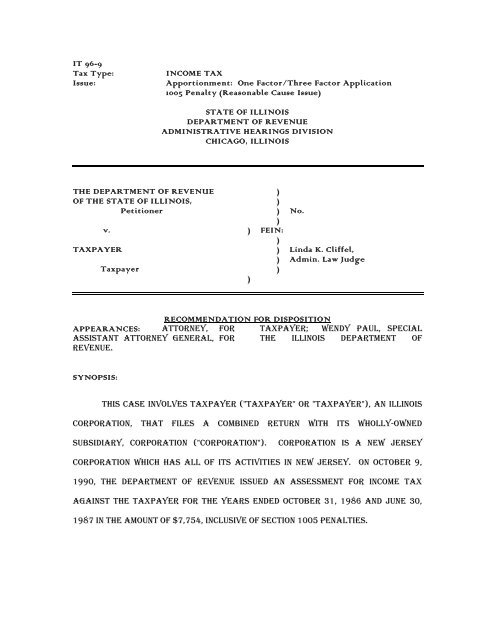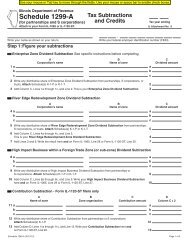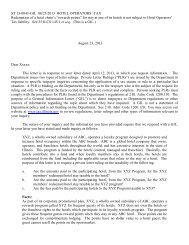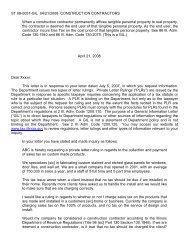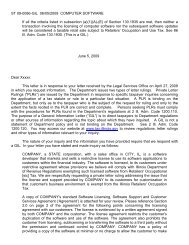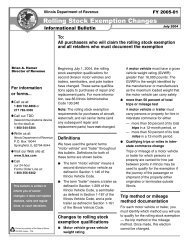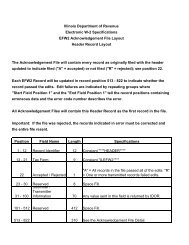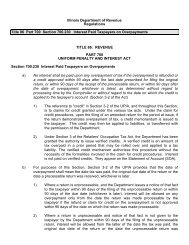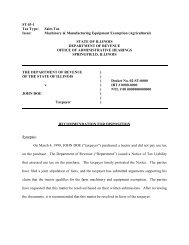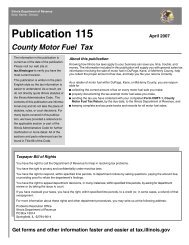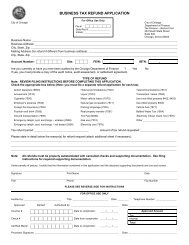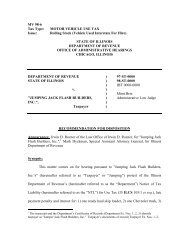IT 96-9 - Illinois Department of Revenue - State of Illinois
IT 96-9 - Illinois Department of Revenue - State of Illinois
IT 96-9 - Illinois Department of Revenue - State of Illinois
You also want an ePaper? Increase the reach of your titles
YUMPU automatically turns print PDFs into web optimized ePapers that Google loves.
<strong>IT</strong> <strong>96</strong>-9<br />
Tax Type: INCOME TAX<br />
Issue: Apportionment: One Factor/Three Factor Application<br />
1005 Penalty (Reasonable Cause Issue)<br />
STATE OF ILLINOIS<br />
DEPARTMENT OF REVENUE<br />
ADMINISTRATIVE HEARINGS DIVISION<br />
CHICAGO, ILLINOIS<br />
THE DEPARTMENT OF REVENUE )<br />
OF THE STATE OF ILLINOIS, )<br />
Petitioner ) No.<br />
)<br />
v. ) FEIN:<br />
)<br />
TAXPAYER ) Linda K. Cliffel,<br />
) Admin. Law Judge<br />
Taxpayer )<br />
)<br />
RECOMMENDATION FOR DISPOS<strong>IT</strong>ION<br />
APPEARANCES: ATTORNEY, for TAXPAYER; Wendy Paul, Special<br />
Assistant Attorney General, for<br />
<strong>Revenue</strong>.<br />
the <strong>Illinois</strong> <strong>Department</strong> <strong>of</strong><br />
SYNOPSIS:<br />
This case involves TAXPAYER ("TAXPAYER" or "Taxpayer"), an <strong>Illinois</strong><br />
corporation, that files a combined return with its wholly-owned<br />
subsidiary, CORPORATION ("CORPORATION"). CORPORATION is a New Jersey<br />
corporation which has all <strong>of</strong> its activities in New Jersey. On October 9,<br />
1990, the <strong>Department</strong> <strong>of</strong> <strong>Revenue</strong> issued an assessment for income tax<br />
against the taxpayer for the years ended October 31, 1986 and June 30,<br />
1987 in the amount <strong>of</strong> $7,754, inclusive <strong>of</strong> Section 1005 penalties.
This matter comes on before the Office <strong>of</strong> Administrative Hearings<br />
pursuant to the taxpayer's timely protest to the Notices <strong>of</strong> Deficiency<br />
dated November 13, 1990. The following issues are presented:<br />
1. Did the <strong>Department</strong> err in eliminating intercompany sales from<br />
the denominator <strong>of</strong> the sales factor for sales from CORPORATION to<br />
TAXPAYER where excluding intercompany sales increased taxpayer's<br />
overall state tax burden; and<br />
2. If it is determined that the deficiency assessed against the<br />
taxpayer is correct, should the Section 1005 penalty be abated due to<br />
reasonable cause.<br />
A hearing was held and evidence was taken by way <strong>of</strong> testimony<br />
regarding the issues. On consideration <strong>of</strong> these matters, it is recommended<br />
that these issues be resolved in favor <strong>of</strong> the <strong>Department</strong>.<br />
FINDINGS OF FACT:<br />
1. TAXPAYER ("TAXPAYER"), an <strong>Illinois</strong> corporation located in Chicago, is<br />
the parent company <strong>of</strong> CORPORATION ("CORPORATION"), a New Jersey<br />
corporation located in New Jersey. For the taxable years ending October<br />
31, 1986 and June 30, 1987, TAXPAYER and CORPORATION filed an <strong>Illinois</strong><br />
combined return. (Dept. Ex. No. 2; Tr. p. 6).<br />
2. Both companies filed separate company returns in New Jersey and<br />
Georgia, and also filed unitary returns in California and New York. (Dept.<br />
Ex. No. 2).<br />
3. TAXPAYER and CORPORATION filed a consolidated federal income tax<br />
return. (Dept. Ex. No. 2).
4. CORPORATION manufactures lighting fixtures, and all <strong>of</strong> their sales are<br />
to the parent company, TAXPAYER, which is the distributor. (Tr. p. 10).<br />
5. Taxpayer eliminated the pr<strong>of</strong>it on intercompany sales from income in<br />
the combined <strong>Illinois</strong> return which was filed for the tax years ended<br />
October 31, 1986 and June 30, 1987. (Dept. Ex. No. 8, 9; Tr. p. 12)<br />
6. When filing its <strong>Illinois</strong> combined return for the years ending October 31,<br />
1986 and June 30, 1987, taxpayer included intercompany sales in its sales<br />
factor. (Tr. pp. 27-28).<br />
7. When intercompany sales were eliminated from the sales factor by the<br />
<strong>Department</strong>, taxpayer was taxed on 115% <strong>of</strong> its income, versus 107% when<br />
intercompany sales were included, for an increase <strong>of</strong> tax liability <strong>of</strong> 10%<br />
in 1986 and 18% in 1987. (Tr. pp. 13-15).<br />
CONCLUSIONS OF LAW:<br />
ISSUE #1<br />
The primary issue presented here is the proper apportionment<br />
formula to be used by the taxpayer. The taxpayer does not contest that<br />
it is a unitary business nor that the filing <strong>of</strong> a combined return is proper.<br />
Taxpayer objects to the exclusion <strong>of</strong> intercompany sales between<br />
CORPORATION and TAXPAYER from the denominator <strong>of</strong> the sales factor.
This case hinges on the interpretation <strong>of</strong> Regulation Section<br />
100.3320(d) 1 . This Regulation provides:<br />
Unitary business income; eliminations;<br />
intercompany transactions. Elimination <strong>of</strong> income<br />
and deduction items arising from transactions<br />
between members <strong>of</strong> the group must be done<br />
whenever necessary to avoid distortion <strong>of</strong> the<br />
group's income, the denominators used by all<br />
members <strong>of</strong> the group in calculating<br />
apportionment factors, or the numerators used<br />
by any particular member <strong>of</strong> the group in<br />
calculating its apportionment factors.<br />
86 Admin. Code, ch. I, Sec. 100.3320(d).<br />
Taxpayer maintains that it should include intercompany sales in the<br />
denominator <strong>of</strong> the sales factor in those states where it files unitary<br />
returns in order to avoid distortion. By including intercompany sales,<br />
taxpayer is taxed on 107% <strong>of</strong> its income by all jurisdictions, versus 115% <strong>of</strong><br />
income if intercompany sales are excluded. Taxpayer argues that since<br />
the exclusion <strong>of</strong> intercompany sales results in an overall higher state<br />
tax burden, the <strong>Department</strong> cannot mandate the elimination <strong>of</strong><br />
intercompany sales. I disagree.<br />
In the case at hand we are dealing with eliminating intercompany<br />
sales from the sales factor <strong>of</strong> a unitary group. CORPORATION's sales are<br />
all to the parent, TAXPAYER, and then the same product is sold to third<br />
parties by TAXPAYER. If the intercompany sales were included in the sales<br />
factor, sales <strong>of</strong> the same product would be included twice. If CORPORATION<br />
were a division <strong>of</strong> TAXPAYER, where one company both manufactured and<br />
distributed the light fixtures, the payroll and property <strong>of</strong> the<br />
manufacturing division would be located in New Jersey, and the sales<br />
factor would consist only <strong>of</strong> sales made to third parties. A unitary<br />
1 Formerly Section 100.3510(d).
eturn is designed to arrive at the same result since the entire business<br />
enterprise is viewed as a single economic unit. Thus, when filing as a<br />
unitary group, it is necessary to eliminate intercompany transactions in<br />
order to accurately measure the sales activity <strong>of</strong> the group.<br />
Other states reflect <strong>Illinois</strong>' position. Both California and New<br />
York, the other states where taxpayer files a unitary returns, require<br />
the elimination <strong>of</strong> intercompany sales from the sales factor <strong>of</strong> combined<br />
returns. See Section 1190, California UD<strong>IT</strong>PA Manual (1984) 2 ; Section 4-4.7,<br />
NY Corp. Franchise Tax Regulations 3 . Also, Section 1717 <strong>of</strong> the Multistate<br />
Tax Commission's Audit Procedure Manual, Corporate Income Tax (1987)<br />
states,<br />
Intercompany Eliminations -- 1717.1. In general,<br />
revenues from interaffiliate sales between<br />
members <strong>of</strong> a combined group <strong>of</strong> corporations<br />
conducting a unitary business are to be<br />
eliminated from the sales factor. This avoids a<br />
duplication in the factor amounts. If Corporation<br />
A sells goods to Corporation B at $90 and B sells<br />
to outsiders at $100, only the $100 enters the<br />
total sales factor; the $90 is eliminated as an<br />
interaffiliate sale... Only intercompany revenues<br />
between corporations that are unitary are<br />
eliminated. Thus, nonunitary interdivisional<br />
sales within a corporation and sales between<br />
non-unitary entities are not eliminated. The<br />
sales factor includes only sales to purchasers<br />
outside the unitary group. (emphasis added)<br />
When the Regulation Section 100.3320(d) refers to "distortion," it is<br />
distortion <strong>of</strong> the combined group's income and how the income is attributed<br />
to the <strong>State</strong> <strong>of</strong> <strong>Illinois</strong>. The proper analysis here is not what percentage<br />
2 "Sales Factor -- The sales factor for a combined unitary group is comprised <strong>of</strong> total gross receipts less<br />
intercompany gross receipts."<br />
3 "The receipts factor on a combined report is computed as though the corporations in the report were one<br />
corporation. All intercorporate business receipts are eliminated in computing the combined business receipts<br />
factor. Intercorporate receipts are receipts by any corporation included in the combined report from any<br />
other corporation included in the combined report."
<strong>of</strong> taxpayer's income is taxed throughout the United <strong>State</strong>s, but whether<br />
<strong>Illinois</strong>' method fairly reflects taxpayer's activity within the <strong>State</strong>. The<br />
Supreme Court enumerated the requirements for fairness <strong>of</strong> an<br />
apportionment methodology in Container Corp. <strong>of</strong> America v. Franchise Tax<br />
Board, 463 U.S. 159 (1983):<br />
463 U.S. at 170.<br />
The first, and again obvious, component <strong>of</strong><br />
fairness in an apportionment formula is what<br />
might be called internal consistency - that is, the<br />
formula must be such that, if applied by every<br />
jurisdiction, it would result in no more than all <strong>of</strong><br />
the unitary business income being taxed. The<br />
second and more difficult requirement is what<br />
might be called external consistency - the<br />
factor or factors used in the apportionment<br />
formula must actually reflect a reasonable<br />
sense <strong>of</strong> how income is generated. The<br />
Constitution does not "invalidat[e] an<br />
apportionment formula whenever it may result in<br />
taxation <strong>of</strong> some income that did not have its<br />
source in the taxing <strong>State</strong>...." Moorman Mfg. Co. [v.<br />
Bair], 437 U.S. [267], 272, 98 S.Ct. at 2344 [(1978)]<br />
(emphasis added). See Underwood Typewriter Co.<br />
[v. Chamberlain], 254 U.S. [113], 120-121, 41 S.Ct., at<br />
46-47 [(1920)]. Nevertheless, we will strike down<br />
the application <strong>of</strong> an apportionment formula if<br />
the taxpayer can prove by 'clear and cogent<br />
evidence' that the income attributed to the <strong>State</strong><br />
is in fact 'out <strong>of</strong> all appropriate proportions to<br />
the business transacted...in that <strong>State</strong>,' Hans<br />
Rees' Sons, Inc. [v. North Carolina ex rel.<br />
Maxwell], 283 U.S. [123], 135, 51 S. Ct. at 389<br />
[(1931)] or has 'led to a grossly distorted result,'<br />
Norfolk and Western RR v. <strong>State</strong> Tax Commission,<br />
390 U.S. 317, 326, 88 S.Ct. 995, 1001, 19 L.Ed.2d 1201<br />
(1<strong>96</strong>8)." Moorman Mfg. Co., supra, 437 U.S., at 274, 98<br />
S.Ct., at 2345.<br />
Taxpayer relies on GTE Automatic Electric v. Allphin, 68 Ill.2d 326,<br />
369 N.E.2d 841 (1977), for the proposition that no more than 100% <strong>of</strong> the<br />
combined group's income may be subject to tax by the various states.<br />
Taxpayer's reliance on GTE is misplaced. The Court in GTE stated "[t]he
purpose <strong>of</strong> the uniform act 4 and article 3 <strong>of</strong> the <strong>Illinois</strong> act is to assure<br />
that 100%, and no more or no less, <strong>of</strong> the business income <strong>of</strong> a corporation<br />
doing multistate business is taxed by the <strong>State</strong>s having jurisdiction to tax<br />
it." 68 Ill. 2d at 335. The Court has merely stated the goal <strong>of</strong> formulary<br />
apportionment. If all the states adopted the uniform act (UD<strong>IT</strong>PA), then no<br />
more than 100 percent <strong>of</strong> a taxpayer's income would be taxed. In fact, if<br />
all <strong>of</strong> the jurisdictions where taxpayer is subject to tax employed the<br />
same methodology used by the <strong>Department</strong>, the result would be that<br />
exactly 100% <strong>of</strong> taxpayer's income is subject to tax.<br />
Taxpayer's problem is that it also files tax returns in New Jersey<br />
which does not allow combined reporting. Since New Jersey does not allow<br />
unitary filing, all income <strong>of</strong> both companies are subject to tax: 100% <strong>of</strong><br />
CORPORATION's income including intercompany pr<strong>of</strong>its (which are eliminated<br />
in a unitary return), and a percentage <strong>of</strong> TAXPAYER's income according to<br />
its apportionment factors in New Jersey. As a result, more than 100<br />
percent <strong>of</strong> taxpayer's income is subject to tax in the various jurisdictions<br />
in which it does business.<br />
As a result <strong>of</strong> the <strong>Department</strong>'s exclusion <strong>of</strong> the intercompany sales<br />
from the sales factor, taxpayer has experienced an increase in its<br />
<strong>Illinois</strong> tax liability <strong>of</strong> 10% in 1986 and 18% in 1987. In Container, the<br />
Supreme Court held a 14% increase in tax to be "within the substantial<br />
margin <strong>of</strong> error inherent in any method <strong>of</strong> attributing income among the<br />
components <strong>of</strong> a unitary business." Id. at 185. See also, Citizens Utilities Co.<br />
v. Dept. <strong>of</strong> <strong>Revenue</strong>, 111 Ill. 2d (1986), (Court upheld a 213% increase in tax<br />
liability); Filtertek, Inc. v. Dept. <strong>of</strong> <strong>Revenue</strong>, 186 Ill. App. 3d 208 (2nd Dist.<br />
1989), (Court upheld increases <strong>of</strong> 561% and 807% to income in <strong>Illinois</strong>); New<br />
4 Reference is to Uniform Division <strong>of</strong> Income for Tax Purposes Act ("UD<strong>IT</strong>PA").
Yorker Magazine v. Dept. <strong>of</strong> <strong>Revenue</strong>, 187 Ill. App. 3d 931 (1st Dist. 1989),<br />
(Court upheld taxes on 120% <strong>of</strong> its combined circulation and advertising<br />
revenues and 128% <strong>of</strong> its advertising revenues).<br />
Ultimately, the issue is not a mathematical test <strong>of</strong> what<br />
percentage <strong>of</strong> income being taxed is acceptable, or by how much does<br />
taxpayer's liability increase. The relevant analysis is whether the<br />
methodology employed by the <strong>State</strong> <strong>of</strong> <strong>Illinois</strong> fairly apportions<br />
taxpayer's income to the <strong>State</strong> <strong>of</strong> <strong>Illinois</strong> based upon its activity in the<br />
<strong>State</strong>.<br />
No evidence has been introduced by taxpayer which would indicate<br />
that the <strong>State</strong>'s method <strong>of</strong> apportionment taxes extraterritorial values.<br />
Taxpayer has failed to rebut the prima facie correctness <strong>of</strong> the<br />
<strong>Department</strong>'s proposed assessment.<br />
ISSUE #2<br />
Taxpayer has requested that in the event that the <strong>Department</strong>'s<br />
position is upheld regarding the elimination <strong>of</strong> intercompany sales that<br />
the Section 1005 penalties should be abated due to reasonable cause. I<br />
disagree.<br />
Taxpayer has manipulated the apportionment factors to<br />
artificially reduce the amount <strong>of</strong> tax it pays to the <strong>State</strong> <strong>of</strong> <strong>Illinois</strong>.<br />
Elimination <strong>of</strong> intercompany transactions is the norm when filing combined<br />
or consolidated returns in order to avoid duplication. See Audit Procedure<br />
Manual, Corporate Income Tax, Section 1717, Multistate Tax Commission<br />
(1987) supra. In addition, it should be noted that taxpayer did eliminate<br />
intercompany sales when calculating taxable income.
Taxpayer presented no evidence regarding how the apportionment<br />
formula as applied by the <strong>Department</strong> resulted in allocating income to<br />
<strong>Illinois</strong> that was out <strong>of</strong> proportion to taxpayer's activity in this <strong>State</strong>.<br />
Therefore, I find that taxpayer did not show reasonable cause for its<br />
underpayment <strong>of</strong> tax, so that the Section 1005 penalties stand.<br />
WHEREFORE, for the reasons stated above, it is my recommendation that<br />
the Notice <strong>of</strong> Deficiency should be finalized in its entirety.<br />
Date: _________________________________<br />
Linda K. Cliffel<br />
Administrative Law Judge


